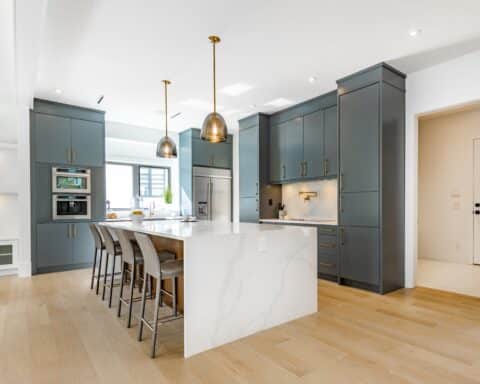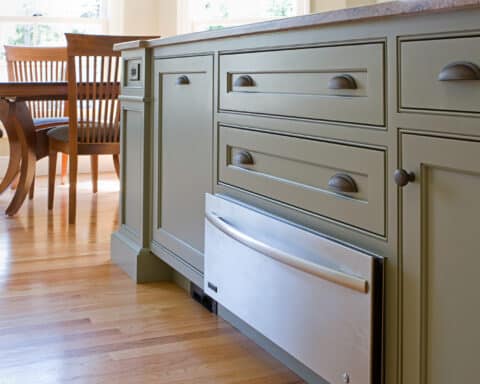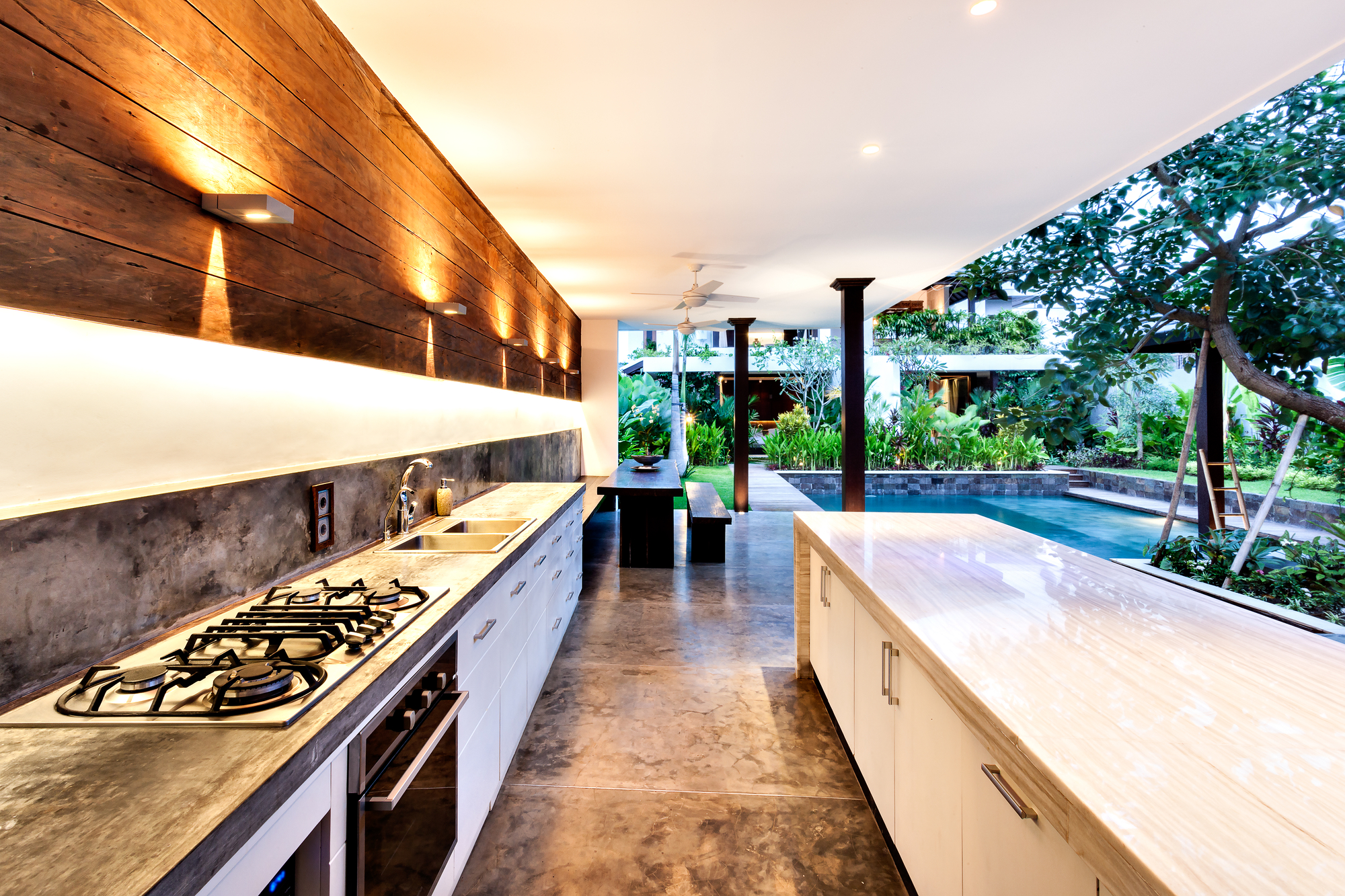Selecting the perfect cabinetry to meet your client’s needs can be challenging with the endless options available. As a builder, you want
Read More →Embrace the Heart of Your Home: Exploring Kitchens as the Central Gathering Spot for Family and Friends
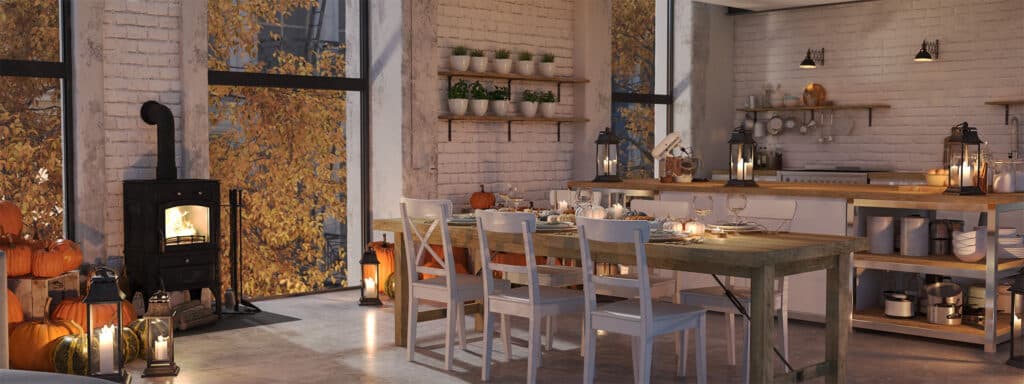
Kitchens are central to many homes, often serving as not only a place for preparing meals but also a gathering spot for family and friends. They come in a wide range of styles and designs, varying based on functionality, size, aesthetics, and cultural and regional preferences.
In most homes, we gather here to prepare meals and, so often, create wonderful memories with family and friends. Given the incredible impact kitchen can have on our lives, it is understandable why it is the focus of the owner’s design ambitions.
Big or small, grand or simple, the kitchen is truly the center of our living.
In this article, we take time to map out the decisions that define this wonderful space. Take notes as you move from topic to topic, envisioning what is possible in your home.
- How appliances change the production in your kitchen
- Is there ever enough storage in a kitchen?
- Countertops are the most trendy design element
- Cabinetry determines everything
- Don’t underestimate the lighting
- The infinite world of flooring
- Sustainability and the new kitchen
- How smart are our kitchens?
Enter title here
The most common kitchen layouts include the one-wall kitchen, the galley kitchen, the L-shaped kitchen, the U-shaped kitchen, and the island kitchen. The selection of a layout largely depends on the available space, the homeowner’s cooking habits, and the desired flow of traffic.
While this is often and largely determined when a home is designed, kitchen remodeling is a big industry. There are no bounds to the creativity of home remodelers, especially those keen on squeezing more out of the kitchen. That said, there are certain design principles which ensure a properly functioning kitchen. The most important is the “kitchen triangle” principle. The kitchen triangle connects the three main work areas: the sink, the refrigerator, and the stove. The idea is that when these three elements are in close (but not too close) proximity to one other, the kitchen will be easy and efficient to use, reducing the amount of movement required between the areas.
How appliances change the production in your kitchen
Modern kitchens typically include appliances like refrigerators, stoves, ovens, microwaves, and dishwashers. Advanced models now feature smart technology, including touch controls, energy efficiency, and Wi-Fi connectivity for remote operation.
European trends in kitchen design have heavily influenced the new features and functions of appliances. Smart technology is on the rise, to be sure. In addition, one can select from a growing menu of cooking technologies like steaming, sealing, and other food-prep methods.
Is there ever enough storage in a kitchen?
Storage is always at a premium in homes. There is also the theory that homeowners will collect as much “stuff” as there is room to store it. Efficient storage solutions, like pull-out drawers, rotating shelves, vertical dividers for trays and baking sheets, and custom inserts for utensils, help keep kitchens tidy and organized.
The McMansion introduced the trend of larger and larger kitchens. Sure, this might help the storage problem, but one must still observe the cooking triangle. It is also true, that the kitchen is the primary entertaining site in one’s home. We will continue to find ways to accommodate larger crowds while still respecting the chef.
Countertops are the most trendy design element
Second to cabinets, countertops add a splash of design intrigue to a kitchen. Durable materials for countertops are crucial. Quartz and granite have remained popular for their durability and aesthetic appeal. Other options include solid surface, wood, laminate, stainless steel, marble, and recycled materials.
Backsplashes often match the countertop material, color and design. These not only protect the walls from splashes and stains but also add a unique design element. Options range from ceramic or porcelain tiles, glass, stainless steel, to natural stone.
Cabinetry determines everything
The design and color of kitchen cabinets play a significant role in defining the overall aesthetic of the kitchen. Popular styles range from sleek modern designs to more traditional looks with detailed woodwork. Kitchen cabinetry determines the look, feel, and efficiency of a kitchen. In Europe, cabinets are considered furniture. In fact, upper cabinets hang on a rail, designed such to allow the homeowner the option of taking that furniture with them. Base cabinets are built with legs, rather than the common US design of a box sitting on the side wall of each individual SKU.
Cabinetry provides essential storage solutions, allowing you to keep your kitchen tidy and organized. The type of cabinets, their layout, and the number of shelves and drawers influence how efficiently you can store your kitchen items. This influences what sits on your counters. For some, an uncluttered countertop is the desired aesthetic. For others, bowls of fruit and wire baskets of herbs is part of the design.
Though the architect influences much of the functionality of a kitchen, the arrangement of cabinets affects the kitchen’s workflow, defining the “place” for specific appliances and functions. Well-placed cabinets can improve the efficiency of tasks like cooking, cleaning, and food preparation. Features like pull-out shelves, lazy susans, and built-in organizers enhance the cabinets’ functionality and make kitchen tasks more manageable. Cabinets can be designed to make the most of the available space in the kitchen. This is particularly important in smaller kitchens, where efficient utilization of space is crucial. Properly installed cabinets contribute to a safe kitchen environment by preventing clutter and ensuring heavy items are stored securely.
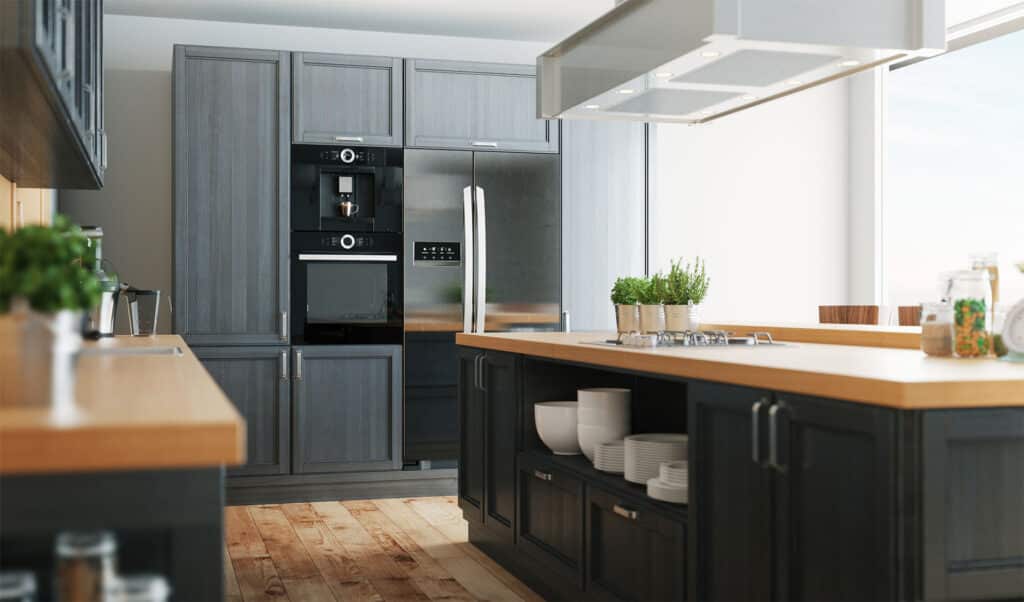
The design, color, and material of the cabinets significantly impact the kitchen’s aesthetics. They can set the tone for the entire kitchen’s style, from traditional to modern or rustic to contemporary. Like the furniture found in other rooms, cabinets say most about the design ambition of the home’s owners.
Kitchen cabinetry is a major factor in determining a home’s resale value. High-quality, well-designed cabinets can significantly increase the appeal and value of a property. The choice of materials for cabinetry affects its durability and how long it will last without showing significant signs of wear and tear.
Finally, kitchen cabinetry can have a significant impact on the overall cost of kitchen remodeling or construction. The material, style, and customization options can vary widely in price.
Don’t underestimate the lighting
A kitchen is a blend of so many different design choices and elements. A mix of general, task, and accent lighting is generally recommended. Under-cabinet lighting, for example, provides excellent task lighting for food preparation. Pendant lights can add a special touch to any kitchen design. Smart lighting and lighting controls allow the home owner to adapt to different occasions, elevating the entertainment experience.
The infinite world of flooring
Choices for kitchen flooring must consider durability and ease of cleaning. Hardwood floors, ceramic tile, laminate, vinyl, and natural stone are common choices. We will leave the full breadth of flooring choices to a future post.
Sustainability and the new kitchen
There’s been an increased emphasis on environmentally friendly kitchens, with energy-efficient appliances, sustainable materials for countertops and cabinets, and water-saving fixtures becoming more common.
There is so much more that we can do to improve sustainability in our homes. Sustainable kitchens not only benefit the environment but also create healthier living spaces and can save money in the long run by reducing energy and water consumption.
Choose kitchen appliances with high energy efficiency ratings. Look for appliances with the ENERGY STAR label, which indicates they meet strict energy efficiency guidelines. Energy-efficient appliances consume less electricity, helping to reduce your carbon footprint and lower energy bills.
Opt for eco-friendly materials for cabinetry, countertops, and flooring. Sustainable options may include bamboo, reclaimed wood, recycled materials, or materials with low environmental impact, such as quartz or recycled glass countertops.
Install low-flow faucets, aerators, and water-efficient dishwashers to reduce water consumption. Collecting and reusing water for gardening or cleaning can also be an eco-friendly practice. This goes beyond the kitchen. The homes of tomorrow will implement graywater recycling systems that collect water from showers, bathtubs, and laundry for reuse in irrigation and other non-potable applications. Proper treatment and filtration ensure the water is safe for the intended purposes.
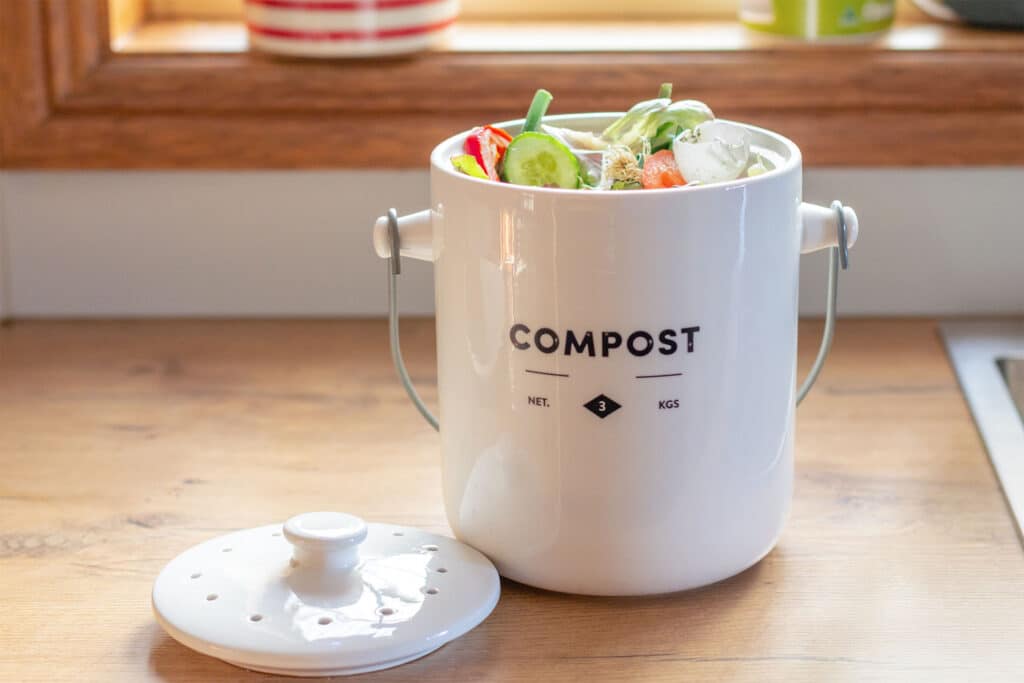
Implement a waste separation system in your kitchen with designated bins for recyclables, compostables, and non-recyclable waste. Recycling and composting kitchen waste can divert a significant amount of material from landfills.
Maximize natural lighting in your kitchen to reduce the need for artificial lighting during the day. This not only saves energy but also creates a pleasant and inviting atmosphere. Use LED light bulbs in your kitchen, as they consume less energy and have a longer lifespan compared to traditional incandescent bulbs.
Ensure your kitchen has efficient ventilation to remove cooking odors, smoke, and indoor air pollutants. This helps maintain a healthier indoor environment and reduces the need for air conditioning.
Choose environmentally friendly cleaning products that are biodegradable and free from harmful chemicals. You can also make your own cleaning solutions using natural ingredients like vinegar and baking soda.
Consider adopting sustainable cooking practices, such as meal planning to reduce food waste, using locally sourced and seasonal ingredients, and reducing meat consumption (as meat production has a significant environmental impact).
Invest in high-quality kitchen elements that are built to last. Durable materials and well-constructed cabinets and appliances will require fewer replacements over time.
How smart are our kitchens?
As mentioned, the integration of technology into the kitchen is a growing trend. This includes smart appliances that can be controlled remotely, but also things like smart faucets, lighting, and even digital assistants.
Kitchen appliances like refrigerators, ovens, dishwashers, and microwaves have become smarter. They are equipped with internet connectivity, touchscreens, and voice recognition features. These appliances can be controlled remotely through smartphone apps or integrated with virtual assistants like Amazon Alexa or Google Assistant. For example, you can preheat your smart oven remotely or check the contents of your fridge while at the grocery store.
Voice-controlled devices have gained popularity in the kitchen. Virtual assistants can help you with recipes, measurement conversions, set timers, and answer cooking-related queries without having to touch any device. This hands-free operation is particularly useful when your hands are busy or dirty while cooking. Some companies offer smart kitchen hubs or panels that centralize control of various kitchen devices and provide recipe suggestions, cooking tips, and more. There are robotic cooking devices designed to automate the cooking process for specific recipes, reducing the need for hands-on involvement.
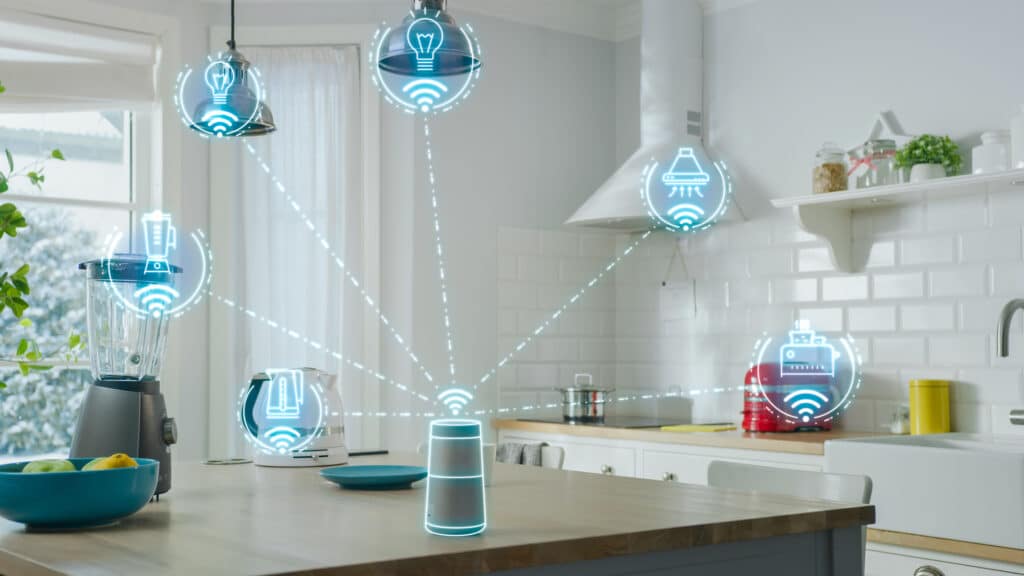
Smart fridges can do more than just keep your food cold. They have built-in cameras that allow you to see the contents of your fridge remotely. Some models also have touchscreen displays that can display recipes, calendars, and even play music or stream videos. They can also send expiration date reminders and grocery shopping lists to your phone.
Induction cooktops with smart technology can connect to apps on your phone to monitor cooking times and adjust temperatures. They can also provide feedback on the ideal cookware placement for even heating.
Digital scales and measuring tools can be connected to smartphone apps to help you follow recipes accurately and achieve precise measurements. Some of these apps can even suggest alternative ingredient measurements if you’re short on a particular ingredient.
Wi-Fi-enabled coffee makers allow you to schedule brewing times from your phone or use voice commands to make your coffee without leaving your bed or work area.
Many smart kitchen devices can communicate with each other, creating a seamless cooking experience. For instance, when you select a recipe on your smartphone app, it can automatically adjust oven settings, and the corresponding cooking instructions appear on a smart display.
Smart technology is also being utilized to optimize energy usage in the kitchen. Some appliances can analyze your usage patterns and make adjustments to conserve energy and reduce waste.
Billy has spent his career leading change and innovation. As he will attest, great achievement is the result of clear vision and gifted collaborators.
A native to the Chicago area, Billy moved from Southern California in 2019 to join Kolter Homes as their Palm Beach County Vice President. He founded two real estate development companies: The Roslin Group, which focused on designing and building mixed-use communities in the Midwest; and Wyndham Development Group, which built residential properties in Chicago’s northwest suburbs.
Your tile title
Related Posts
Are you thinking of upgrading your kitchen and wondering where to start? Have you considered adding a warming drawer to enhance both
Read More →Shopping for a new freezer can be a daunting task. With a range of different types, features, and brands to choose from,
Read More →In the world of construction, appliances need to meet specific requirements that revolve around functionality, durability, and cost-effectiveness. This guide is dedicated
Read More →
